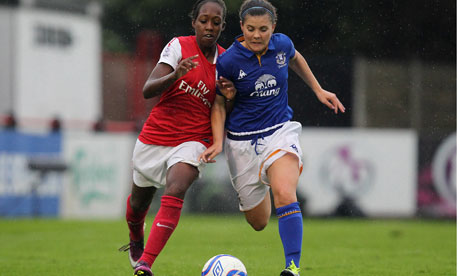
After years of feeling underrated and overlooked by mainstream football pundits and press, women's football is coming into its own this season thanks to social media.
New research shows that the women's version of the game is now the third biggest team sport in the UK in terms of participation, behind only men's football and cricket.
Its previous lack of recognition is being overcome by fans turning to social networking to follow the sport. The second ever season of the Football Association's Women's Super League (WSL) kicks off on Sunday, and eight of England's top female footballers, one from each of the top clubs, will take the unprecedented step of wearing their success on their sleeve by displaying their Twitter account names on their kit.
The new semi-professional league, the top tier of women's football, was launched by the FA last year as a platform to drive forward the women's game and the association claims that it will be spending £3m on promotion in the first three years of the league.
Since the WSL launched, attendances have increased by more than 600%, viewing figures of live broadcast matches, at 450,000, are on a par with those of the men's Scottish Premier League, and the social media channels now attract more than 80,000 followers. It has transformed the player-fan relationship by making it a fully interactive league. Research commissioned for the FA by Sport England Active People ahead of the 2012 season shows that the low profile of women's football is what is driving fans to Twitter and Facebook for news. Fans are up to seven times as interactive as those of the men's game.
The Fifa women's world cup was the most tweeted-about event in the world in July 2011 with 7,196 tweets per second at its peak. It remains seventh in the list of the most tweets per second, above the Uefa Champions League in 11th position.
But the findings show that while there are 12 times as many news articles with mentions of women's football per month, relative to the number of people who attend matches, men's football receives three times as many headlines, relative to the number of fans who attend.
"It is understandable in a way," said England international and Arsenal Ladies midfielder Steph Houghton. "It's difficult because the men's game is so big and attracts so much money and sponsorship and so it's always going to take priority.
"But with digital media we can really forge ahead. We don't need to struggle to get a few lines in a newspaper, we can do it for ourselves; fans can interact with players and find out about fixtures and get really involved on match days – even if they are not at the game themselves."
Houghton, 23, has been selected as the FA WSL digital ambassador for Arsenal Ladies this season. Each club in the league will pick one player who will wear their Twitter address.
"Twitter and Facebook have helped us massively, it's just transformed things over the past year," Houghton said. "It's really progressing the game. Our attendance figures have increased a lot. We're doing a lot of work in schools getting girls to play football, breaking down any taboos there might be, and we're seeing them get interested, and bring their families along where they have such a good match day experience that they're coming back.
"I think that what's happening is that girls are enjoying playing. It's a lot more acceptable and now we have a Women's Super League with hugely dedicated female role models – really committed players who people can see are dedicated and training as hard if not harder than any male players – that's all progressing the sport. And with social media there's no holding women's football back."
Kelly Simmons, the FA's Head of the National Game, said: "When we launched the FA WSL last year we set out to be a truly interactive league by inviting fans to have a say and to get closer to the players through social media channels. Since then we have increased supporters inside and outside of the stadium, but consistent awareness and recognition remains challenging.
"This research shows that there is an appetite for content about women's football, but the sport rarely makes headlines. We want to continue to interact with fans in exciting ways and make 2012 a starting point for greater support for women's football."
Tweet @FAWSL using #supportoursport

